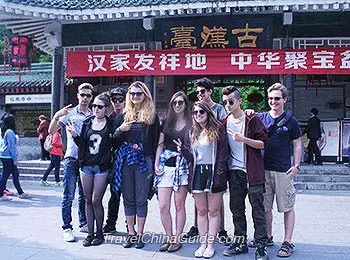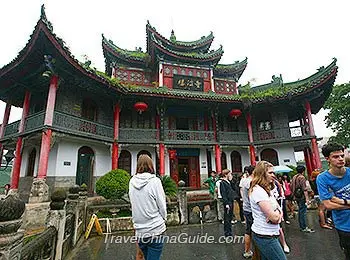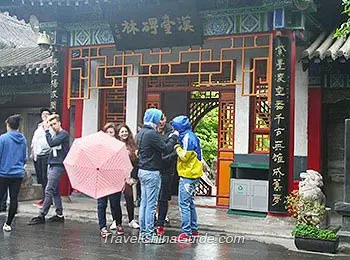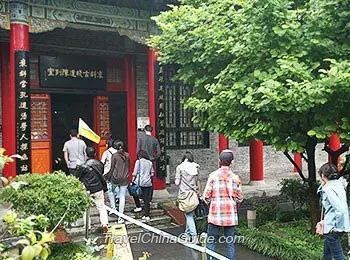Hanzhong Museum (Ancient Hantai)
Ancient Hantai is the relics of the royal residence where Liu Bang (founder of Han Dynasty) lived in when he was demoted as the King of Hanzhong. In 1958, it was chosen as the site of Hanzhong Museum and many buildings in Ming and Qing dynasty (1368 – 1911 AD) style were built for housing historical relics. Currently, the collection has reached 12,000 pieces, including stone inscriptions, excavated cultural relics, ancient paintings and calligraphy, modern history records of the city, ancient fossils and religious statues.
Walking into the museum, tourists will see a hathpace which is 23 feet (7 meters) high. Facing south, it mainly consists of three mesas, and rises via steps northwards. It was once the royal residence of Liubang when he was demoted to Hanzhong. Afterwards, he defeated his rival, established the Han Dynasty (202 BC - 220 AD), and moved to Changan (nowdays Xi'an). In order to memorize him, his former residence was named Ancient Hantai and regarded as the 'root' of Han Dynasty by later generations.
Lying on the top of the Ancient Hantai, nowadays, is Wangjiang Pavilion (Watch River Tower) with a height of 60 feet (17 meters). Built in the Southern Song (1127 - 1279) style, it is the ancient landmark building in the city. It is said that Wangjiang Pavilion was the best location to admire the river in ancient times.
On both sides of the pavilion lie the Bronze Bell Pavilion and Stone Drum Pavilion. An exquisite and priceless bronze bell is placed in the east pavilion. The bell was said to be the relic of the Ming Dynasty (1368 - 1644 AD). The stone drum in the west pavilion is also called Yuetai Beryl, which was the horse-mounting stone of Liu Bang. It is also one of the eight famous scenic spots in Hanzhong.
In front of the Wangjiang Pavilion lies the Guiyin Hall (Osmanthus Shadowed Hall). Tourists can find osmanthus trees in front of the hall. Those osmanthus trees will be in their full bloom when it comes to the mid-Autumn Festival, making the whole place full of osmanthus scent. Inside the Guiyin Hall, tourists can appreciate historical relics of Han Dynasty.
The two buildings to the east and west sides of Guiyin Hall are Donghua Hall and Xihua Hall, which are used to place the relics related to revolution in Hanzhong and ancient paintings and calligraphy respectively.
A lake is located to the south of Guiyin Hall, Jingwu Lake (Mirroring Oneself Lake), which was first built in the Qing Dynasty (1644 - 1911). It is rectangle shaped, 40 feet (12 meters) long and 20 feet (5.8 meters) wide. An arch bridge carved with patterns of dragon and tiger can be seen. A poem named Jingwuchi is engraved on a round stone lying beside the lake.
To the south of the Jingwu Lake is situated the south courtyard of Hantai that is also called Forest of Stone Steles, one of the most important groups of collections in the museum. There are two exhibition halls here:
One is Baoxie Plank Road Exhibition Hall which is divided into three parts. The first part shows the trend of seven ancient plank roads leading to Hanzhong from other places; the second displays how the Stone Gate tunnel, world’s first mountain tunnel, was made and the third tells tourists how the post house was set up in ancient times.
Another hall displays the Stone Gate Thirteen Precipice Inscriptions which is praised as national treasure. One world-famous relic is the inscriptions on the cliffs in the Han Dynasty and Wei Dynasty (220-265). It has great value for the study of the development of transport, irrigation, science and technology and calligraphic art in ancient times. It is named as "the Gem of China" and "the Calligraphy Treasury".
 How to get to Hanzhong Museum:
How to get to Hanzhong Museum:
Located on No. 26 East Street of Hantai District, visitors can take bus line 9, 21, 22 to get there.
 Nearby Attractions:
Nearby Attractions:
 Baijiang Altar: One of the Three Relics (Ancient Hantai, Baijiang Altar and Horsepond) of Western Han (202 BC - 9 AD); this place bears a beautiful environment.
Baijiang Altar: One of the Three Relics (Ancient Hantai, Baijiang Altar and Horsepond) of Western Han (202 BC - 9 AD); this place bears a beautiful environment.
Ancient Hantai
|
|
Wangjiang Pavilion
On both sides of the pavilion lie the Bronze Bell Pavilion and Stone Drum Pavilion. An exquisite and priceless bronze bell is placed in the east pavilion. The bell was said to be the relic of the Ming Dynasty (1368 - 1644 AD). The stone drum in the west pavilion is also called Yuetai Beryl, which was the horse-mounting stone of Liu Bang. It is also one of the eight famous scenic spots in Hanzhong.
Guiyin Hall and Jingwu Lake
The two buildings to the east and west sides of Guiyin Hall are Donghua Hall and Xihua Hall, which are used to place the relics related to revolution in Hanzhong and ancient paintings and calligraphy respectively.
A lake is located to the south of Guiyin Hall, Jingwu Lake (Mirroring Oneself Lake), which was first built in the Qing Dynasty (1644 - 1911). It is rectangle shaped, 40 feet (12 meters) long and 20 feet (5.8 meters) wide. An arch bridge carved with patterns of dragon and tiger can be seen. A poem named Jingwuchi is engraved on a round stone lying beside the lake.
|
|
Forest of Stone Stele
One is Baoxie Plank Road Exhibition Hall which is divided into three parts. The first part shows the trend of seven ancient plank roads leading to Hanzhong from other places; the second displays how the Stone Gate tunnel, world’s first mountain tunnel, was made and the third tells tourists how the post house was set up in ancient times.
Another hall displays the Stone Gate Thirteen Precipice Inscriptions which is praised as national treasure. One world-famous relic is the inscriptions on the cliffs in the Han Dynasty and Wei Dynasty (220-265). It has great value for the study of the development of transport, irrigation, science and technology and calligraphic art in ancient times. It is named as "the Gem of China" and "the Calligraphy Treasury".
Located on No. 26 East Street of Hantai District, visitors can take bus line 9, 21, 22 to get there.
| Admission Fee | Free Note: All visitors need to get a ticket before entry with a valid ID certificate like passport. |
| Opening Hours | March to November: 8:30 - 17:00; with last at 16:30 December to the next February: 9:00 - 17:00; and the last ticket is at 16:30 Note: The museum is closed on Mondays (except the legal holidays). |
- Last updated on Aug. 13, 2025 by Demi Li -



